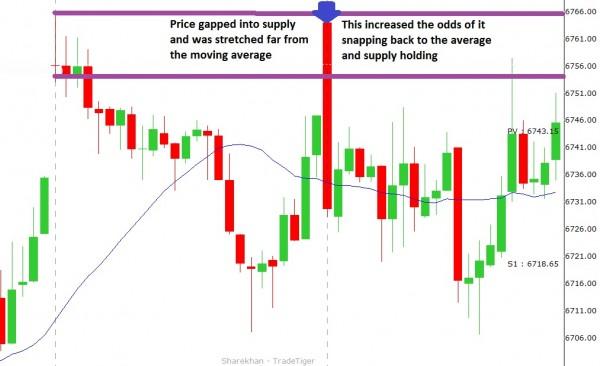Most traders are familiar with moving averages. They are a useful technical tool for identifying the direction and strength of a trend. However, many traders overlook a very useful characteristic of price that allows us to identify a trading opportunity using moving averages. That characteristic is elasticity.
Prices are elastic. They will move away from an average and then snap back. They repeat this process in a trend over and over, stretching away from that average before returning. In a trend, however, the average will slowly move in the direction of the trend thus making the price cover less distance when retracing.
Imagine a rubber band. If you stretch the band slightly, it will snap back to its original shape. If you stretch the band further, you will have a more violent snap back to the original shape. Price acts in a similar manner. If you observe price stretching away from an average, it will snap back as soon as it strikes a level of supply or demand. Stretch price further, such as a parabolic move, and you will often experience a stronger return.
This elasticity is due to the actions and emotions of the people trading and investing in the stock/commodity/index/currency. It works the same on any security. If you go to the store and your favorite product is marked down on sale, you are more likely to buy it or even buy more of it. If inflation caused the price of the product to rise, you may buy less of it, not buy it at all, or look for a substitute to buy.
The same occurs with securities. When price is below the average price, it is undervalued and a bargain. If it moves to an extreme away from the average then it becomes irresistible to traders and investors who will rush in to buy it and send the price higher. The traders will stop buying when it reaches the average price since it is no longer a bargain. However, those who missed out on the initial buying spree may try to join and will push prices above the average. If prices extend too far above an average, then the price is overvalued and no one will want to buy it. Nervous holders of the security will start to sell and cause prices to drop to… you guessed it, the average.
In the chart, I have used a simple moving average to demonstrate this effect. Note how price will move away from the average and then return after reaching extremes. We can locate high probability long and short entries when this is combined with support and resistance. Typically, when price stretches away from the average, it will extend until it reaches a supply or demand level. These are levels where traders caused the price to reverse in the past. The over or undervalued nature of price being far from the average, added to the fact that the price has reached a level where it turned previously will usually lead traders to take that action again.
This gives us the opportunity to predict where traders will take action and more importantly, where we can profit by acting sooner. There are some important rules that you must keep in mind when trading. Always be mindful of the trend and do not trade against it. For instance, you shouldn’t buy in downtrends. Look to short or close shorts until you have confirmed the trend is reversing. You shouldn’t short in up-trends. Go long or exit according to your analysis. Learning to read price and its relationship to averages is a valuable skill that can be used to trade successfully in any market.
Neither Freedom Management Partners nor any of its personnel are registered broker-dealers or investment advisers. I will mention that I consider certain securities or positions to be good candidates for the types of strategies we are discussing or illustrating. Because I consider the securities or positions appropriate to the discussion or for illustration purposes does not mean that I am telling you to trade the strategies or securities. Keep in mind that we are not providing you with recommendations or personalized advice about your trading activities. The information we are providing is not tailored to any individual. Any mention of a particular security is not a recommendation to buy, sell, or hold that or any other security or a suggestion that it is suitable for any specific person. Keep in mind that all trading involves a risk of loss, and this will always be the situation, regardless of whether we are discussing strategies that are intended to limit risk. Also, Freedom Management Partners’ personnel are not subject to trading restrictions. I and others at Freedom Management Partners could have a position in a security or initiate a position in a security at any time.
Editors’ Picks

AUD/USD Price Forecast: Revisits monthly high around 0.6390 Premium
AUD/USD advances to near 0.6390 despite the escalating trade war between the US and China. US President Trump announced a 90-day pause on reciprocal tariffs for all of his trading partners, except China. Trump’s tariff agenda has kept the US Dollar on the backfoot.

EUR/USD remains offered and below 1.1300
EUR/USD is feeling the squeeze, revisiting the area around 1.1280 as the US Dollar gains extra momentum on Tuesday. Mixed domestic data from Industrial Production and Economic Sentiment haven't done the Euro any favours either.

Gold embarks on a consolidative move around $3,200
Gold is holding its own on Tuesday, trading just above $3,200 per troy ounce as it bounces back from earlier losses. While a more upbeat risk sentiment is bolstering the rebound, lingering concerns over a deepening global trade rift have prevented XAU/USD from rallying too aggressively.

XRP, Dogecoin and Mantra traders punished for bullish bets, will altcoins recover?
Altcoins are recovering on Tuesday as the dust settles on US President Donald Trump’s tariff announcements last week. The President has repeatedly changed his mind on several tariff-related concerns, ushering volatility in Bitcoin and altcoin prices.

Is a recession looming?
Wall Street skyrockets after Trump announces tariff delay. But gains remain limited as Trade War with China continues. Recession odds have eased, but investors remain fearful. The worst may not be over, deeper market wounds still possible.
RECOMMENDED LESSONS
Making money in forex is easy if you know how the bankers trade!
Discover how to make money in forex is easy if you know how the bankers trade!
5 Forex News Events You Need To Know
In the fast moving world of currency markets, it is extremely important for new traders to know the list of important forex news...
Top 10 Chart Patterns Every Trader Should Know
Chart patterns are one of the most effective trading tools for a trader. They are pure price-action, and form on the basis of underlying buying and...
7 Ways to Avoid Forex Scams
The forex industry is recently seeing more and more scams. Here are 7 ways to avoid losing your money in such scams: Forex scams are becoming frequent. Michael Greenberg reports on luxurious expenses, including a submarine bought from the money taken from forex traders. Here’s another report of a forex fraud. So, how can we avoid falling in such forex scams?
What Are the 10 Fatal Mistakes Traders Make
Trading is exciting. Trading is hard. Trading is extremely hard. Some say that it takes more than 10,000 hours to master. Others believe that trading is the way to quick riches. They might be both wrong. What is important to know that no matter how experienced you are, mistakes will be part of the trading process.

The Best brokers to trade EUR/USD
SPONSORED Discover the top brokers for trading EUR/USD in 2025. Our list features brokers with competitive spreads, fast execution, and powerful platforms. Whether you're a beginner or an expert, find the right partner to navigate the dynamic Forex market.


